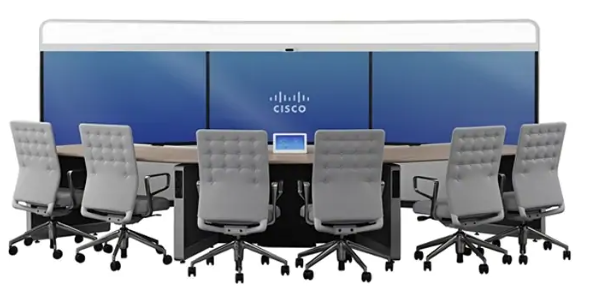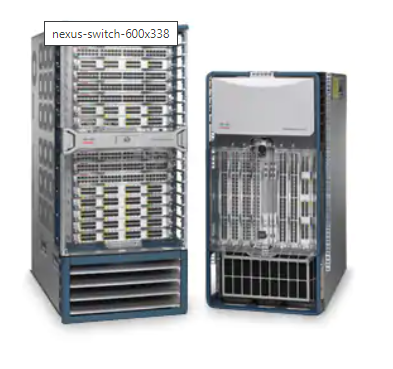This article is About the network active devices for data such as IP Telephony, Switches, Routers, Video Conferencing, Wireless Devices …etc.
Network Active Devices
Network Backbone switches
Cisco Nexus 9000 Series Switches Specifications Requirements
CISCO Nexus 7000 Series Specifications Requirements
a. For the core switching layer, a 4:1 ration should be taken as a guideline for oversubscription of incoming connections to uplink connections.
b. The core switches should always establish 10Gbps uplinks.
c. There should be two redundant Nexus 7000 switches.
d. Each core switch should be a Nexus 7009, 7010 or 7018 – depending on module capacity. Lower denominator of required modules should be the norm.
e. Each Nexus 7000 switch should include redundant power supply units – a minimum of 6000W per unit.
f. Each switch should include a front door kit and an air filter.
g. The Nexus 7000 switch should have the following software as per the requested features:
h. NX-OS Release 5.x or higher at the time of orderability.
i. LAN Enterprise License pack.
j. LAN Enterprise License for Layer 3 protocols.
k. Advanced LAN Enterprise License for VDC.
l. Enhanced Layer 2 License for FabricPATH.
m. Transport Services License for OTV.
n. A minimum of 3 cross-fabric modules should be included per switch. The latest cross-fabric model from the vendor should be chosen.
o. For 10G connectivity, the following is the recommendation:
p. For Layer 2 and FCoE functionality, use the Nexus F1 or F2 line card with a minimum throughput of 230Gbps per slot.
q. For mixed Layer2+3 functionality, use the Nexus M1 or M2 line card with a minimum throughput of 80Gbps.
r. The number of ports should be inline with the number of connections required at the site.
s. Preference should be always given to 10G SFP+ transceivers.
t. All modules should be consistent with the structured cabling specs. For single mode cables that are less than 300 meters, use the SFP-10G-LRM transceiver.
u. For 1Gbps connectivity, the following is recommended:
v. 48-port SFP port M1 or M2 module.
w. Virtual Port Channel (VPC) should be included in the configuration. A total of 4x 10Gbps
connections should be used on each switch for this purpose. Extendable copper twinax
cable should be used where appropriate.
x. DCNM license should be included per switch for management purposes.
y. All power cords should be North America type.
z. 24x7x4 SmartNet for three years should be included per switch.
Nexus 5000 Series Specifications for Server Farm.
a. The Cisco 5548UP is the platform that should be chosen. For higher densities, the Nexus 5596 should be selected for DC access.
b. The base 32 ports should be possible to configure in any of the following mode or a combination of thereof:
c. Ethernet-based with 1 or 10G connectivity per port
d. Fiber channel based with 8Gbps FC connectivity per port
e. FCoE based with 10Gbps connectivity per port
f. Any combination or mix of this list
g. A Layer 3 base license and daughter card/module for the Nexus 5500 should be included
h. DCNM LAN/SAN license should be included per switch
i. All power cords should be North America type
j. 24x7x4 SmartNet for three years should be included per switch
k. If there’s an FC requirement, the storage license should be requested on this switch.
Distribution Switches (option 1):
a) Two redundant Cisco Catalyst 4500 series switches with Dual PS (2800W AC, Data & POE).
b) Catalyst 4500 Supervisor V-10GE, 2x10GE (X2) and 4x1GE (SFP) or higher
c) Catalyst 4500 NetFlow Services Card (Sup IV/V).
d) Catalyst 4500 GE Modules , (WS-X44xx series modules).
e) All Gigabit transceiver’s interfaces must be of type LX (either SFP or GBIC).
Note: Collapse Network is the preferred Design for SABIC i.e. 2 Levels only Access & Backbone, 3 Levels designs are only used where there are strong justifications.
Access Level Switches (Edge Switch):
a) Cisco Catalyst 3560-X Series Switches. 24 or 48 Ethernet 10/100/1000 ports with PoE+
WAN & Internet Routers:
a) Cisco multi-services routes, 29xx, 39xx.
b) Cisco 73xx with ATM Modules
c) Cisco ASR1002 Chassis ( Required for more than 80 Mb WAN Bandwidth),
4 built-in GE, Dual P/S, 4GB DRAM,
SPA for ASR1000; No Physical Part; For Tracking Only
Cisco ASR 1000 Series RP1 WebEx Node
Cisco ASR1000 Embedded Services Processor, 10G
1GB USB Flash Token
Cisco ASR 1000 Series RP1 ADVANCED IP SERVICES
Cisco SPA, WebEx Node for ASR 1000 Series
OC3/STM1 SFP, Single-mode fiber, Intermediate Reach
1 port OC-3c/STM-1 ATM Shared Port Adapter
WAN Optimization:
d) Riverbed when applicable
e) Model selection depends on business size.
f) The Central Management Console (CMC) license is required
Wireless Components (Access Points & Their description):
a) Cisco Light Weight Wireless Access point is the SABIC Standards, the recommended model is (AIR-CAP3502E-E-K9 802.11a/g/n Ctrlr-based AP w/CleanAir; Ext Ant; E Reg Domain) or higher.
b) Wireless Antenna depends on site requirement.
c) Wireless Controller:
d) All Wireless Access Points should be managed & Controlled by Cisco WLAN Controller of Series 5500, depends on the number of APs.
e) f) Cisco WCS Management S/W version 7.0 or higher with proper license should be installed.
Firewalls & Security devices:
A firewall is a network security device that monitors incoming and outgoing network traffic and decides whether to allow or block specific traffic based on a defined set of security rules.
a) Cisco ASA55xx with either IPS or CCS Modules installed.
b) Juniper ISG with IDP installed or NS2XX series with Deep Packet Inspection License.
Telephony
a) Standard for telephony is based on Cisco IP Telephony systems no legacy PABX is acceptable) please refer to document number SSITS-NSD-S05 of Network IP-Telephony.
Video Conferencing:
b) Standard for video conferencing is based on Tandberg and Telepresence is based on CISCO, technical specifications could be identified based on the current business and technical requirements.
For Telepresence solution standard is Cisco. And the model will be depending on the requirement.





